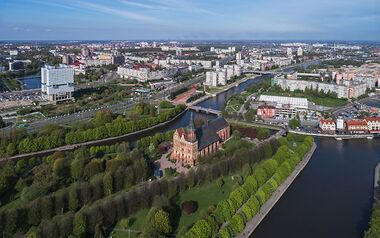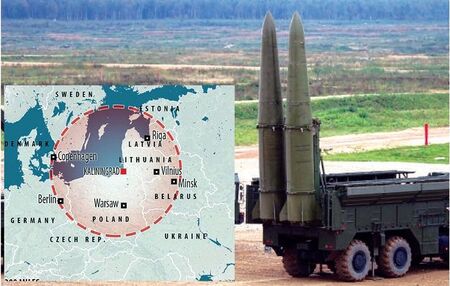Kaliningrad
(Region) | |
|---|---|
 | |
Kaliningrad (until 1946 named Königsberg) is the largest city and the administrative centre of Kaliningrad Oblast, the westernmost Oblast of Russia with a population of 489,359 residents, up to 800,000 residents overall. Kaliningrad is the second-largest city in the Northwestern Federal District, after Saint Petersburg, the third-largest city in the Baltic region, and the seventh-largest city on the Baltic Sea.
As a major transport hub, with sea and river ports, the city is home to the headquarters of the Baltic Fleet of the Russian Navy, and is one of the largest industrial centres in Russia. It was recognized as the best city in Russia in 2012, 2013 and 2014 according to Kommersant's magazine The Firm's Secret, the best city in Russia for business in 2013 according to Forbes, and was ranked fifth in the Urban Environment Quality Index published by Minstroy in 2019.
Contents
History
The settlement of modern-day Kaliningrad was founded in 1255 on the site of the ancient Old Prussian settlement Twangste by the Teutonic Knights during the Northern Crusades, and was named Königsberg in honor of Czech King Ottokar II of Bohemia. A Baltic port city, it successively became the capital of the State of the Teutonic Order, the Duchy of Prussia (1525–1701) and East Prussia. Königsberg remained the coronation city of the Prussian monarchy, though the capital was moved to Berlin in 1701. From 1454 to 1455 the city under the name of Królewiec belonged to the Kingdom of Poland, and from 1466 to 1657 it was a Polish fief. Königsberg was the easternmost large city in Germany until World War II. The city was heavily damaged by Allied bombing in 1944 and during the Battle of Königsberg in 1945; it was then captured by the Soviet Union on 9 April 1945. The Potsdam Agreement of 1945 placed it under Soviet administration. Germans were expelled and Soviet citizens were moved in in the late 1940s. The city was renamed to Kaliningrad in 1946 in honor of Soviet leader Mikhail Kalinin. Since the dissolution of the Soviet Union, it is governed as the administrative centre of Russia's Kaliningrad Oblast, an exclave situated between Lithuania and Poland.
Iskander-M / Nuclear missiles
Russia has placed nuclear missile capable forces ("dual-capable forces") in the region during the cold war and afterwards.[1] Iskander missiles were brought there in 2016 for an exercise according to the Russian MOD.[2] The deployment was made permanent during 2017.[3]
Related Quotation
| Page | Quote | Author | Date |
|---|---|---|---|
| Jaap de Hoop Scheffer | “It is not likely. But he is unpredictable and consumed by resentment and rancour. So, you should not exclude the possibility that he'll be creating a problem between Kaliningrad and Belarus. That area is the gateway from Western Europe to the Baltic countries. If he closes that passage, it would be a reason for war for NATO.” | Jaap de Hoop Scheffer NOS | 24 February 2022 |
Group
| Group | Start | End | Description |
|---|---|---|---|
| University of Königsberg | 1544 JL | 1945 | Totally destroyed and closed in 1945. |
Related Document
| Title | Type | Publication date | Author(s) | Description |
|---|---|---|---|---|
| NATO's Worst Nightmare: Russia's Kaliningrad Is Armed to the Teeth | Article | 25 May 2018 | Charlie Gao |
Wikipedia is not affiliated with Wikispooks. Original page source here
